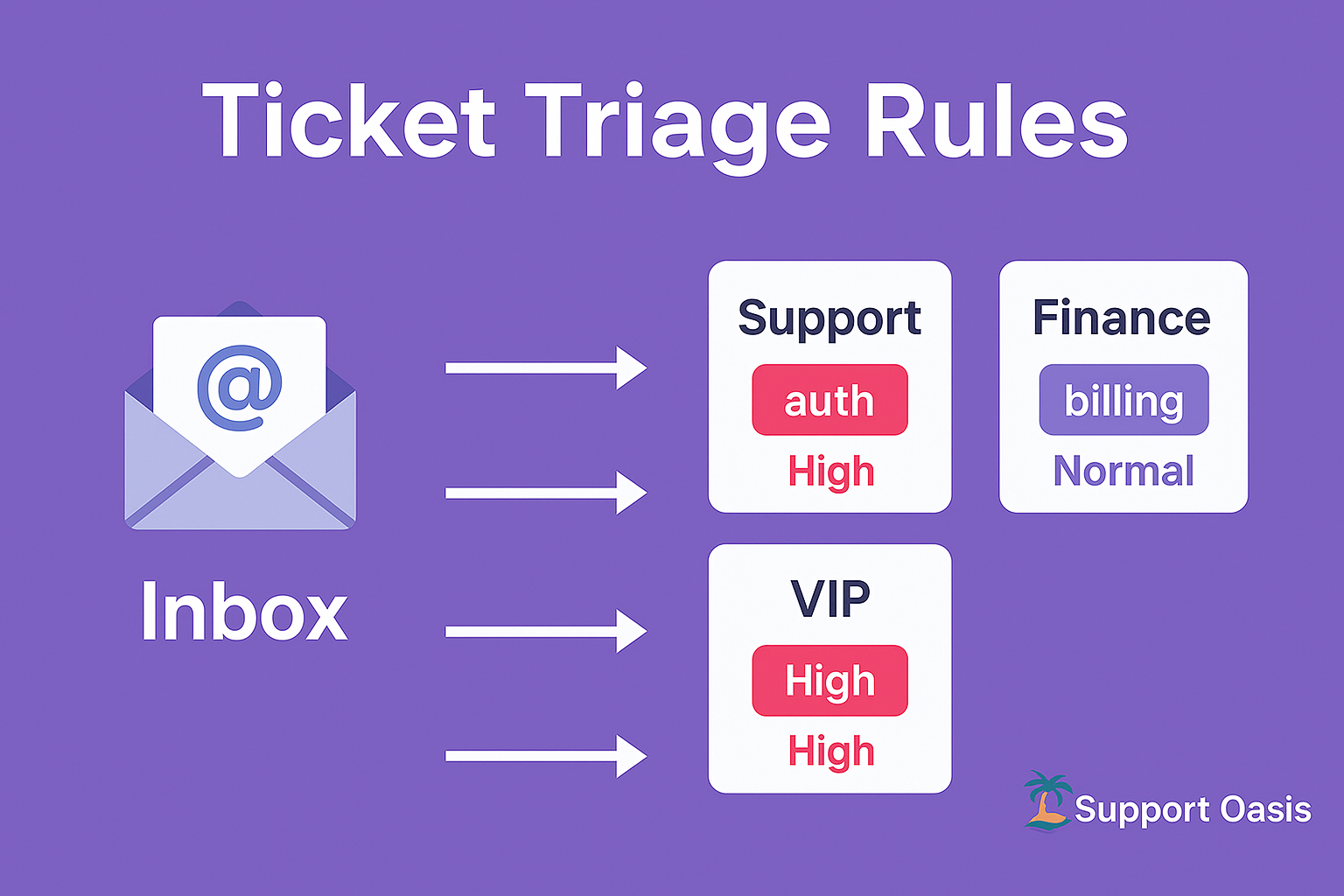Ticket triage rules help small teams route emails fast and keep queues under control. As a result, agents see the right work at the right time. In addition, your customers get faster, clearer replies that build trust.
Ticket Triage Rules: The Basics
First, define the goal. You want the right owner, a clear priority, and a helpful tag on every ticket. Then, decide what should happen when a ticket arrives outside business hours. Finally, confirm who handles urgent issues, so nothing waits overnight.
Email routing rules (synonym)
Start simple, then add depth as volume grows:
- If subject contains “billing,” assign to Finance, set Normal.
- If body includes “cannot log in,” assign to Support, set High.
- If sender domain is a VIP, tag VIP and set High.
Because of this, work lands where it belongs, and your SLA stays safe.
Set Up Triage in One Hour
Step 1: Map your inputs
List sources like support@, contact forms, and integrations. In addition, write one sentence about who should own each source.
Step 2: Create assignment rules
Auto-assign by keyword, sender domain, or form. For example, route “refund” to Finance. Meanwhile, send “bug” to Support.
Step 3: Add priority logic
Use High, Normal, Low. Therefore, urgent issues skip the line. In other words, the clock starts sooner for the work that matters most.
Step 4: Tag for reporting
Add tags for product area, channel, and VIP. Consequently, reports show patterns you can fix.
Step 5: Test and refine
Open three sample tickets. Then confirm assignment, priority, and tags. Finally, tweak wording until rules trigger as expected.
For context on when a team should move beyond a shared inbox, see Gmail vs Helpdesk Software: When Startups Should Upgrade and Shared Inbox vs Helpdesk: Which Is Better for Small Teams?. According to Harvard Business Review, clarity and speed in communication drive customer loyalty, which triage directly supports.
Prioritization That Protects Your SLAs
First response time matters, so keep the model simple. For example:
- High: Outages, account access, VIP issues.
- Normal: Product questions, minor bugs.
- Low: Feedback, general requests.
Moreover, attach targets you can meet. For example, reply to High in one hour, Normal in four, Low in one business day. Therefore, agents know what to do next without guessing.
Auto-assign rules (synonym)
Use owner pools to spread work. In addition, rotate High tickets across the on-call group. Consequently, no one gets overloaded, and your queue stays healthy.
Examples You Can Copy
Start with a few rules, then expand:
- Login errors: Assign Support, set High, tag auth.
- Refund request: Assign Finance, set Normal, tag billing.
- VIP sender: Keep owner, set High, tag vip.
- New feature idea: Assign Product, set Low, tag feature-request.
In short, these rules cover most early-stage cases. Because they are clear, agents learn them fast.
Common Mistakes and Fixes
- Too many rules at once. Instead, launch five that cover 80% of volume.
- No owner of the rules. Appoint one person who reviews and improves them weekly.
- Ambiguous priorities. Define examples for each level, then share them in onboarding.
- Missing tags. Add a small, stable set first. Then expand based on reports.
For lean setup ideas that avoid complexity, review Helpdesk Software Without the Bloat: Tools Built for Lean Teams and Helpdesk for Remote Teams: Best Software for Small Businesses in 2025.
Metrics That Prove Triage Works
Track these weekly. Consequently, you will see what to improve next.
- First response time by priority.
- Resolution time by category.
- Backlog trend over time.
- Reopen rate for quality checks.
Because reports guide changes, plan one small tweak each week. Then measure again, so you learn what works.
Final Thoughts
Effective ticket triage rules give small teams speed, clarity, and control. As a result, agents focus on the right work, and customers feel the difference. In conclusion, start simple, refine weekly, and keep priorities clear.
Ready to route emails faster?
Try Support Oasis for free to launch email routing, priorities, and tags in minutes. Try for free or learn more about Support Oasis.
